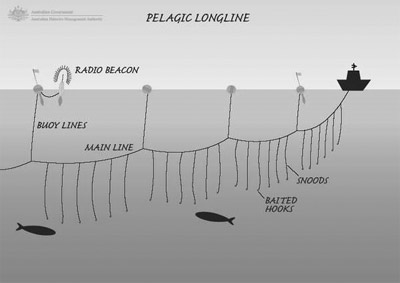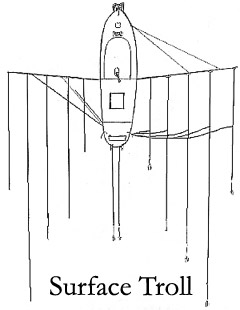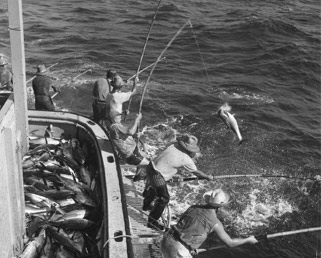|
What are the different
kinds of tuna, and how are they caught?
There are five primary species of fish that are used in canning.
They are caught using a variety of methods. 62% of the fish are
seined with nets, 14% are fished with longlines, and the remainder
are caught with other methods.
| Species |
Market % |
Avg. Size |
Fishing Method |
| Skipjack (Katsuwonus pelamis) |
60% |
7 lbs |
Purse Seine |
| Yellowfin (Thunnus albacares) |
24% |
20 lbs |
Purse Seine, Longline |
| Bigeye (Thunnus obesus) |
10% |
35 lbs |
Purse Seine, Longline |
| Albacore (Thunnus alalunga) |
5% |
40 lbs |
Longline, Surface Troll, Pole and Line |
| Northern Bluefin (Thunnus thynnus) |
<1% |
15 lbs |
Longline, Surface Troll, Pole and Line |
Purse Seine
 This
method of fishing involves a net that can be up to 2000 meters
in length and up to 250 meters deep. The net is carried by a large
vessel as they drive around searching for fish. When a tuna school
is located, the vessel deploys a smaller boat called a skiff which
pulls the net off the primary vessel as the primary vessel drives
around to encircle the tuna in the net. When the tuna have been
encircled in the net, both vessels will come together and the
skiff will give the end of the net back to the main vessel. The
skiff will then hook up to the main vessel to pull on it so that
it will not drift back over the net. The net has floats or corks
at the top and rings at the bottom along with a weighted line
used to sink the bottom of the net into the water. A rope called
a purse line is pulled in through the rings, causing the bottom
of the net to close and keep the fish from escaping. The net is
pulled in aboard the boat until eventually it is very small, at
which point the fish are removed from the net. This
method of fishing involves a net that can be up to 2000 meters
in length and up to 250 meters deep. The net is carried by a large
vessel as they drive around searching for fish. When a tuna school
is located, the vessel deploys a smaller boat called a skiff which
pulls the net off the primary vessel as the primary vessel drives
around to encircle the tuna in the net. When the tuna have been
encircled in the net, both vessels will come together and the
skiff will give the end of the net back to the main vessel. The
skiff will then hook up to the main vessel to pull on it so that
it will not drift back over the net. The net has floats or corks
at the top and rings at the bottom along with a weighted line
used to sink the bottom of the net into the water. A rope called
a purse line is pulled in through the rings, causing the bottom
of the net to close and keep the fish from escaping. The net is
pulled in aboard the boat until eventually it is very small, at
which point the fish are removed from the net.
Longline
 In
longline fishing, a boat sets out a long rope called a main line
that will runs for miles beneath the surface. Attached to this
main line will be several shorter lines called gangions (pronounced
gan-yuns) or snoods. The gangions will have baited hooks for catching
tuna that will have diffrering lengths. The long mainline will
be supported by multiple floats and lines that will keep the main
line at the depth of the fish. After deploying a longline, the
fishing vessel will typically deploy another line, then return
to an earlier set line. When retreiving the line, fish are removed
from the hooks and the main line is re-spooled aboard the vessel. In
longline fishing, a boat sets out a long rope called a main line
that will runs for miles beneath the surface. Attached to this
main line will be several shorter lines called gangions (pronounced
gan-yuns) or snoods. The gangions will have baited hooks for catching
tuna that will have diffrering lengths. The long mainline will
be supported by multiple floats and lines that will keep the main
line at the depth of the fish. After deploying a longline, the
fishing vessel will typically deploy another line, then return
to an earlier set line. When retreiving the line, fish are removed
from the hooks and the main line is re-spooled aboard the vessel.
Surface Troll
 These
vessels use lures that are dragged across the surface behind a
boat that is moving at about 5-6 miles per hour. The lures typically
look like a squid and are made out of rubber or some other durable
material. The hook is a heavy duty double hook, usually without
a barb which allows the fisherman to quickly release the fish. These
vessels use lures that are dragged across the surface behind a
boat that is moving at about 5-6 miles per hour. The lures typically
look like a squid and are made out of rubber or some other durable
material. The hook is a heavy duty double hook, usually without
a barb which allows the fisherman to quickly release the fish.
The boat uses outriggers to allow them to fish more lures (also
called jigs). The lines used are heavy braided cord called tuna
cord which run from the poles. There is typically a shock reducing
device called a rubber snubber on every line which reduces the
chance of losing fish that get hooked. The cord will be connected
to a monofiliment leader that is usually about 2-3 fathoms in
length.
Tuna swim to the surface and bite these jigs. The boat continues
moving, sometimes in a circle, and the crew pull the fish in one
at a time. The hook is removed and quickly returned to the water
to catch another fish.
Pole and Line
 In commercial tuna pole and line fishing, hand-held long
heavy-duty poles without reels are used. A line made of steel
cable or monofilament that is shorter than the fishing pole is
tied to the end of the pole. At the end there will be a hook which
will either be baited or have an artificial jig. After the boat
locates fish, they will approach the school and start throwing
chum (small live bait fish used to attract the tuna). The tuna
will swim to the boat and eat the chum, at which time the crew
members will get in a rack that is mounted outside the boat with
their poles. The artificial jigs or baited hooks are dropped into
the water, and when the tuna bite, the fisherman manually lifts
the tuna out of the water with the pole, flipping the fish into
the boat. The special hook design of the artificial jig quickly
falls out of the mouth of the fish, allowing the fisherman to
quickly put it back into the water without having to even touch
the fish.
In commercial tuna pole and line fishing, hand-held long
heavy-duty poles without reels are used. A line made of steel
cable or monofilament that is shorter than the fishing pole is
tied to the end of the pole. At the end there will be a hook which
will either be baited or have an artificial jig. After the boat
locates fish, they will approach the school and start throwing
chum (small live bait fish used to attract the tuna). The tuna
will swim to the boat and eat the chum, at which time the crew
members will get in a rack that is mounted outside the boat with
their poles. The artificial jigs or baited hooks are dropped into
the water, and when the tuna bite, the fisherman manually lifts
the tuna out of the water with the pole, flipping the fish into
the boat. The special hook design of the artificial jig quickly
falls out of the mouth of the fish, allowing the fisherman to
quickly put it back into the water without having to even touch
the fish.
Out of the fishing methods mentioned above, the most ocean-friendly
methods with the least bycatch of other species and impact to
the environment are surface troll and pole and line. Other species
will frequently bite longlines or be caught in the seine, where
the other two fishing methods almost exclusively catch their target
species.
|